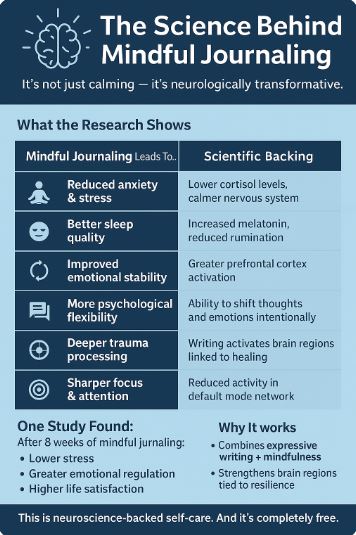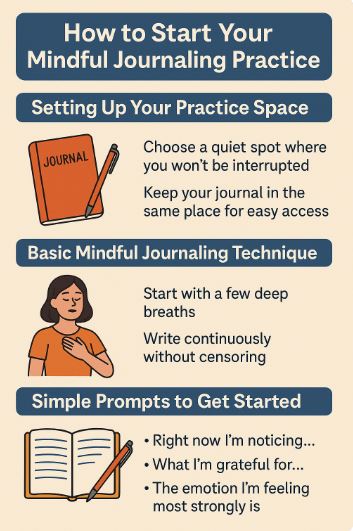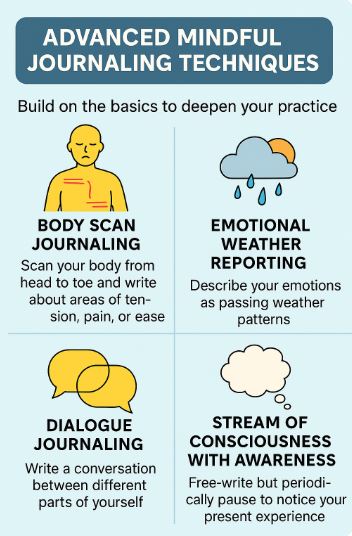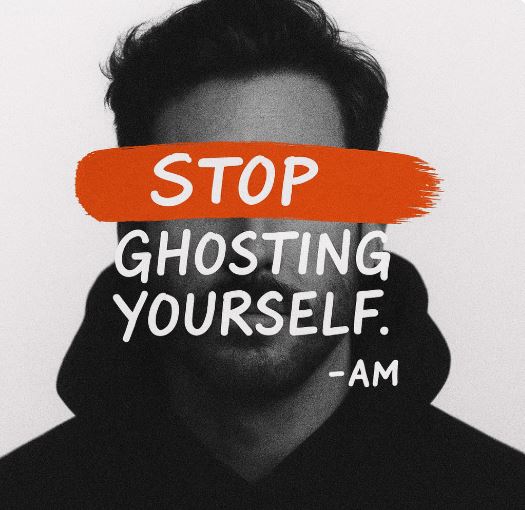Introduction- Mindful Journaling
My therapist handed me a blank notebook three months ago. “Try mindful journaling,” she said. “Write for ten minutes each morning.”
I rolled my eyes. Another trendy self-help technique that probably wouldn’t work.
But I was desperate enough to try anything. My anxiety was through the roof. My thoughts raced constantly. Sleep felt impossible most nights.
Mindful journaling isn’t just writing down your thoughts randomly. It’s a specific practice that combines awareness with reflection. It helps you observe your mental patterns without getting caught in them.
The difference between regular journaling and mindful journaling changed everything for me. Instead of just venting emotions, I started understanding them.
What Makes Mindful Journaling Different
 Regular journaling often becomes a place to dump emotions or complain about problems. You write about what happened and how you feel about it. Sometimes this helps, but often it just rehearses stress.
Regular journaling often becomes a place to dump emotions or complain about problems. You write about what happened and how you feel about it. Sometimes this helps, but often it just rehearses stress.
Mindful journaling approaches writing with intentional awareness. You observe your thoughts and feelings like a curious detective You notice patterns without immediately trying to fix or judge them.
The mindfulness part means staying present with whatever comes up. When your mind wanders to tomorrow’s meetings or yesterday’s mistakes, you gently return attention to this moment. To the pen in your hand and words on the page.
This practice teaches you to witness your mental activity without getting swept away by it. You develop what psychologists call “metacognition” – the ability to think about your thinking.
Over time, mindful journaling creates space between you and your reactive patterns. You stop being controlled by every emotion or anxious thought that pops up during your day.
The written format adds power that mental noting alone doesn’t provide. Writing engages different parts of your brain and creates a permanent record you can review for insights.
The Science Behind Mindful Journaling
 Research shows that mindful journaling activates the prefrontal cortex, the brain region responsible for executive function and emotional regulation. This literally rewires your brain for better stress management.
Research shows that mindful journaling activates the prefrontal cortex, the brain region responsible for executive function and emotional regulation. This literally rewires your brain for better stress management.
Studies have found that people who practice mindful journaling experience reduced anxiety, improved sleep quality, and better emotional stability. The benefits show up in brain scans and stress hormone levels.
Writing about experiences helps process trauma and difficult emotions more effectively than just thinking about them. The act of putting feelings into words activates healing centers in the brain.
Mindful journaling also strengthens what researchers call “psychological flexibility” – your ability to adapt to changing circumstances without getting stuck in rigid thinking patterns.
The mindfulness component adds another layer of benefit. It trains your attention and reduces the default mode network activity associated with depression and anxiety. Your brain literally gets better at staying present.
One study followed people practicing mindful journaling for eight weeks. Participants showed significant improvements in stress levels, emotional regulation, and overall life satisfaction compared to control groups.
The combination of mindfulness and expressive writing creates a powerful tool for mental health that costs nothing but time and attention.
For more inspiration on using journaling to boost mindfulness and emotional clarity, visit this journaling guide from Mindful.org.
How to Start Your Mindful Journaling Practice
 Starting mindful journaling doesn’t require anything special, a simple notebook and pen work perfectly. The key is consistency and intention, not fancy tools.
Starting mindful journaling doesn’t require anything special, a simple notebook and pen work perfectly. The key is consistency and intention, not fancy tools.
Setting Up Your Practice Space
Choose a quiet spot where you won’t be interrupted for 10-15 minutes. This could be your kitchen table before anyone else wakes up, a corner of your bedroom, or even your car during lunch break.
Keep your journal and pen in the same place so you don’t waste time searching. The easier you make it to start, the more likely you’ll maintain the practice consistently.
Some people prefer writing at the same time each day. Morning works well because your mind is clearer before daily stress accumulates. But any consistent time that works for your schedule is perfect.
Basic Mindful Journaling Technique
Start each session with three deep breaths. This signals your nervous system to shift into a calmer state and helps you become present with the practice.
Write continuously for your chosen time period without stopping to edit or censor yourself. If you can’t think of what to write, describe what you’re noticing in this moment.
When you notice your mind judging what you’re writing (“this is stupid” or “I’m not doing this right”), simply acknowledge the judgment and return to writing without fighting it.
End each session by reading what you wrote with curiosity, not criticism. Notice any patterns or insights that emerged during the writing process.
Simple Prompts to Get Started
If you’re staring at a blank page, these prompts can help begin your mindful journaling practice:
“Right now I’m noticing…” and describe whatever comes to awareness. Physical sensations, emotions, thoughts, or sounds around you.
“What I’m grateful for in this moment is…” This shifts your brain toward appreciation and present-moment awareness instead of problem-focused thinking.
“The emotion I’m feeling most strongly is…” Then explore where you feel it in your body and what thoughts accompany it without trying to change anything.
“If my stress could speak, it would say…” This creates distance between you and overwhelming feelings by personifying them as separate from your identity.
Advanced Mindful Journaling Techniques
 Once you’re comfortable with basic mindful journaling, these techniques can deepen your practice and provide specific benefits for different situations.
Once you’re comfortable with basic mindful journaling, these techniques can deepen your practice and provide specific benefits for different situations.
Body Scan Journaling
Start by scanning your body from head to toe, noticing areas of tension, relaxation, pain, or comfort. Write about what you discover without trying to fix anything.
This technique helps you develop body awareness and notice how emotions show up physically. Many people carry stress in their shoulders, jaw, or stomach without realizing it.
Regular body scan journaling can help you catch stress early before it builds into overwhelming anxiety or physical symptoms that disrupt your daily life.
Emotional Weather Reporting
Describe your emotional state like a weather report. “Today my inner weather is stormy with scattered thoughts and a chance of worry later.”
This metaphor creates healthy distance from intense emotions. Instead of “I am anxious,” you can observe “anxiety is visiting today like a thunderstorm that will pass.”
Weather language helps normalize emotional fluctuations as natural and temporary rather than permanent states that define who you are as a person.
Dialogue Journaling
Write conversations between different parts of yourself. The worried part might talk to the wise part, or the critical voice might dialogue with the compassionate voice.
This technique helps you access different perspectives within yourself and develop internal resources for handling challenges. It’s like having a therapy session with yourself.
Many people discover they have more wisdom and self-compassion available than they realized when they give these inner voices space to express themselves on paper.
Stream of Consciousness with Awareness
Write whatever comes to mind for a set time, but include periodic awareness breaks. Every few sentences, pause and notice: “What am I feeling right now as I write this?”
This combines free-flowing expression with mindful check-ins. You get the benefits of emotional release plus the awareness training that makes mindful journaling so powerful.
Specific Benefits of Regular Mindful Journaling
 People who maintain consistent mindful journaling practices report improvements in multiple areas of life. These benefits typically develop gradually over weeks or months of regular practice.
People who maintain consistent mindful journaling practices report improvements in multiple areas of life. These benefits typically develop gradually over weeks or months of regular practice.
Stress and Anxiety Reduction
Mindful journaling helps you identify stress triggers before they overwhelm your system. You start noticing early warning signs and can respond more better to challenging situations.
The practice teaches your nervous system that it’s safe to feel difficult emotions without being consumed by them. This reduces the secondary stress of fighting your own feelings.
Many people find that worries lose their power when written down mindfully. Problems that felt enormous in your head often seem more manageable on paper.
Improved Emotional Regulation
Regular practice strengthens your ability to stay present with emotions without immediately reacting. You develop what therapists call “emotional tolerance” – the capacity to feel without being overwhelmed.
Mindful journaling helps you recognize emotional patterns and choose better responses. Instead of automatically snapping at family members when stressed, you notice the stress early and address it directly.
You also develop greater self-compassion as you practice observing your experiences with curiosity rather than harsh judgment. This inner kindness naturally extends to how you treat others.
Enhanced Self-Awareness
The regular practice of mindful observation helps you understand your unique patterns, triggers, and needs. You become an expert on your own mental and emotional landscape.
This self-knowledge leads to better decision-making in relationships, career choices, and daily life. You learn to honor your authentic needs instead of people-pleasing or following others’ expectations.
Many people discover limiting beliefs or self-talk patterns they weren’t aware of. Once you see these patterns clearly, you can begin to change them consciously.
Better Sleep Quality
Writing about your day and current concerns before bed helps your brain process experiences and worries. This mental clearing often leads to more restful sleep.
The mindfulness component teaches you to notice when your mind starts racing at bedtime. Instead of getting caught in worry spirals, you can redirect attention to breath or body sensations.
Many people use evening mindful journaling as a transition ritual between the day’s activities and sleep. It signals your nervous system that it’s time to wind down and rest.
Common Challenges and How to Handle Them
 Every mindful journaling practice encounters obstacles. Understanding these challenges helps you work through them instead of giving up when difficulties arise.
Every mindful journaling practice encounters obstacles. Understanding these challenges helps you work through them instead of giving up when difficulties arise.
“I Don’t Have Time”
Start with just five minutes daily. Most people can find five minutes, even on busy days. The consistency matters more than the length of each session.
Consider mindful journaling while drinking your morning coffee, during lunch breaks, or before bed. You don’t need a perfect block of uninterrupted time to benefit from the practice.
Remember that this practice often saves time by reducing stress, improving focus, and helping you make better decisions throughout your day.
“I Don’t Know What to Write”
This is completely normal, especially when starting. Begin by describing what you’re noticing right now – sounds, physical sensations, emotions, or thoughts.
You can also write about not knowing what to write. “I’m sitting here feeling stuck and uncertain about what to put on this page…” This is perfect material for mindful journaling.
The goal isn’t to produce beautiful or insightful writing. It’s to practice present-moment awareness while engaging with your inner experience through words.
“My Mind Judges Everything I Write”
Notice the judging voice with curiosity rather than fighting it. You might write, “I notice my mind saying this is stupid and pointless right now.”
The judgment is just another mental event to observe mindfully. It doesn’t mean you’re doing anything wrong or that the practice isn’t working for you.
Over time, this accepting awareness actually reduces the power of your inner critic. You stop taking those harsh voices so seriously when you see them clearly.
“I Get Overwhelmed by Emotions”
If intense emotions arise during mindful journaling, try shortening your sessions or focusing more on physical sensations than emotions.
Remember that feeling emotions doesn’t mean drowning in them. You can experience sadness, anger, or fear while maintaining some observing awareness that these are temporary states.
If emotions feel unmanageable, consider working with a therapist alongside your journaling practice. Professional support can help you process difficult experiences safely.
Making Mindful Journaling a Sustainable Habit
The benefits of mindful journaling come from consistent practice over time, not from perfect sessions or dramatic insights. Here’s how to maintain your practice long-term.
Start Smaller Than You Think
Most people begin with overly ambitious plans like journaling for 30 minutes daily. This usually leads to missing days and eventually giving up entirely.
Start with just 5-10 minutes on most days. You can always extend the time later, but beginning with something sustainable is more important than starting perfectly.
It’s better to journal for five minutes consistently for months than to have a few perfect 30-minute sessions followed by weeks of nothing.
Link It to Existing Habits
Attach mindful journaling to something you already do regularly. After your morning coffee, before checking email, or while dinner cooks in the oven.
This “habit stacking” makes it easier to remember and creates natural cues for your new practice. You don’t have to rely on motivation or memory alone.
The existing habit serves as a trigger that reminds you to journal, making consistency much more likely over time.
Expect Imperfection
Some days your mind will be scattered. Other days you’ll feel resistant to writing. This is completely normal and doesn’t mean you’re failing at the practice.
Even chaotic or resistant journaling sessions provide valuable awareness. You might notice, “I’m feeling really scattered today and judging myself for it.”
The practice works through consistency, not through having perfect or profound sessions every time.
Track Your Practice Simply
Keep a simple record of days you journal, perhaps by marking an X on a calendar. This visual feedback helps maintain motivation and shows your progress.
Don’t track quality or insights, just consistency. The goal is to show up regularly, not to have breakthrough moments every session.
Celebrate small wins like journaling for a week straight or maintaining the practice during a stressful period. These victories build confidence and momentum.
Integrating Mindful Journaling with Daily Life
The real power of mindful journaling comes when the awareness you develop during writing sessions extends into your daily activities and relationships.
Using Insights in Real Time
As you become familiar with your patterns through journaling, you’ll start noticing them as they happen during your day. This real-time awareness allows for more skillful responses.
You might catch yourself falling into worry spirals and remember insights from your journal about what triggers this pattern. This knowledge helps you interrupt the cycle earlier.
The self-compassion you practice during journaling naturally extends to how you treat yourself when you make mistakes or face challenges throughout your day.
Sharing Appropriately with Others
Mindful journaling often provides clarity about relationship dynamics and communication patterns. You can use these insights to have more honest conversations with people you care about.
However, your journal is primarily for your own processing. Be thoughtful about what insights you share and how you share them with others.
The emotional regulation skills you develop through journaling help you communicate more calmly during conflicts and express your needs more clearly.
Conclusion
Mindful journaling offers a simple yet powerful way to develop greater self-awareness, emotional regulation, and inner peace. The practice requires no special equipment or extensive training – just willingness to show up consistently.
The combination of mindfulness and expressive writing creates a unique tool for mental health that research shows can be as effective as therapy for many people.
Start with just five minutes tomorrow morning. Choose a quiet spot, take three deep breaths, and write about what you notice in this moment. Don’t worry about doing it perfectly.
Your inner world deserves this kind of gentle, curious attention. Through mindful journaling, you can develop a healthier relationship with your thoughts and emotions that serves you for life.
The practice teaches you that you are not your thoughts or feelings – you are the aware presence that can observe them with wisdom and compassion.
What aspect of mindful journaling feels most appealing to you? Which challenge do you think you’ll need to work through first?
Toxic Traits: What They Really Are (And Why We All Have Them) (Part 1)







